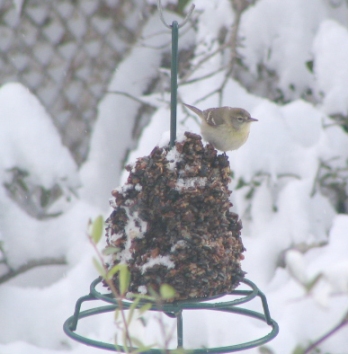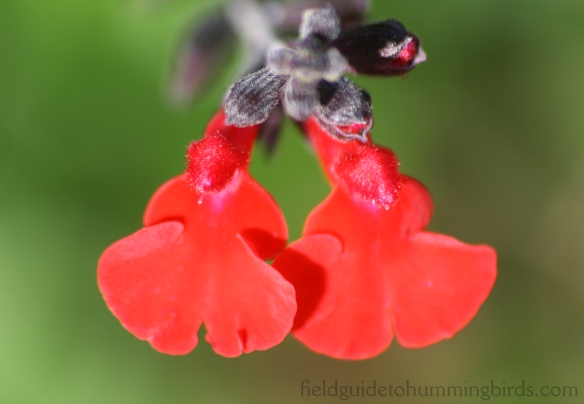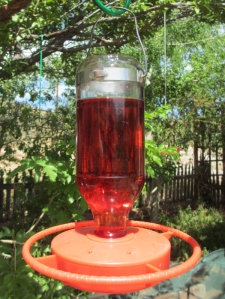This post is adapted from an article that originally appeared in 2010 in my “Out the Window” column in WildBird magazine. Though the focus is vagrant hummingbirds of migratory species, many of the issues apply equally to semi-migratory hummingbirds such as Anna’s that have expanded their range into areas where winter survival depends on feeders.

A hungry male Anna’s Hummingbird fills his crop moments after a thick layer of fresh snow was brushed off the feeder. Anna’s are the most cold-tolerant of all North American hummingbirds, but even they can’t survive extended periods of subfreezing weather without help from their human hosts.
For more than 20 years I’ve been telling people that it takes more than a bottle of sugar water to keep a healthy hummingbird on the breeding grounds when its instincts tell it to head south. Though that’s still true, it doesn’t apply to the increasing numbers of vagrant hummingbirds whose instincts lead them not to the tropics or the relatively mild southern and coastal parts of the U.S. but to cold latitudes where their chances of long-term survival are slim.
In some cases, these seemingly lost and doomed migrants do make it through the winter with a little help from their human friends, even surviving to return the following fall. It’s the less fortunate ones and the dilemmas they pose for their hosts and admirers that caused me to rethink my longstanding advice to leave hummingbird feeders up in fall.
The vast majority of wild birds live and die without a single human ever taking a personal interest in their welfare, but hummingbirds aren’t most birds. Their deceptive daintiness and apparent dependence on our gardens and feeders trigger much stronger and more complex emotions in us. Small wonder, then, that firestorms of controversy often erupt over whether, when, and how to help vagrant hummingbirds that are struggling to cope with brutal northern winters.
Unfortunately, there’s no one-size-fits-all approach to dealing with tiny birds in trouble. A hands-off policy, as heartless as it may seem, would be the logical choice if wintering hummingbirds were getting by entirely on natural resources. Once artificial feeders and the people who tend them enter the picture, “letting nature take its course” is no longer an option. It’s not so easy to talk about natural selection when you have to look that hummingbird in the eye each morning as it huddles on its slushy feeder.
Intervention has its own hazards, even when left to licensed experts (as required by federal law). The “Three Rs”— Rescue, Rehabilitate, and Release—may fail if delayed until the bird is too weak to survive the stress of capture or if the specialized care it needs is unavailable. Some wildlife rescue groups are reluctant to take in hummingbirds because they don’t have the expertise or resources to provide proper care.
New problems arise when the rescuers decide to add a fourth “R”: Relocate. It was once common practice to capture vagrant hummingbirds, even those in no obvious distress, and fly or drive them hundreds of miles to warmer climes. As we learned more about hummingbird migration, we realized that in most cases this is a spectacularly bad idea. Like many other birds, hummingbirds learn the particulars of their migration routes by experience. Without that experience, a bird that manages to survive capture and relocation may end up permanently disoriented. Release at or near the original rescue site allows the bird to reorient itself to familiar landmarks in preparation for the next leg of its journey, whether further south or back towards its breeding grounds.
When to release a rescued hummingbird can be just as important as where, especially for early-migrating species such as Rufous and Allen’s. Their northward migration along the Pacific Coast is well underway in January and February, when much of the U.S. is still in the grip of winter. Releasing a hummingbird in the dead of winter isn’t as crazy as it may sound. Some of the tougher species have been observed to hang on through blizzards and ice storms only to move on once the weather cleared.

This Pine Warbler is no better adapted to winter weather than most hummingbirds, but few people would advocate capturing it for relocation or permanent captivity.
Another misguided approach is to sentence “defective” hummingbirds to life in captivity. Though modern zoo ethics discourage taking wildlife out of the wild, this was exactly what happened to a Green-breasted Mango that found its way to southern Wisconsin in the autumn of 2007. This spectacular bird, only the second member of its mainly tropical species ever seen north of southern Texas, was preemptively rescued ahead of a winter storm and transported to a wildlife rehabilitation center. Against the advice of numerous hummingbird experts, center officials decided to turn the bird over to the Brookfield Zoo in Chicago. Members of the hummingbird community lobbied for the bird’s release either back in Wisconsin or in the lower Rio Grande Valley of Texas, but zoo officials were determined to add this avian celebrity to the collection. The following fall a late-migrating Ruby-throated from Michigan ended up at the same zoo under similar circumstances, again against the advice of experts.
How do we keep hummingbirds out of these predicaments in the first place? One simple change in your feeder routine could make a huge difference. Switching to a sugar-water ratio of 1:3 by early September, when high-risk birds may be passing through, will help your visitors put on fat more efficiently while still providing essential water. The higher sugar content also lowers the solution’s freezing temperature without making it too syrupy for hummingbirds to drink, so it’s the perfect recipe for winter feeding as well. Most hummingbirds take to the sweeter solution right away, but you can gradually increase the sugar content over several days to avoid alienating your regular clientele.
Of course, the ultimate solution to the problem is to stop feeding hummingbirds before winter sets in. If you live north of USDA Plant Hardiness Zone 7a (average minimum winter temperatures 5 to 10̊ F.) and would prefer not to take on the responsibility of hosting a wintering hummingbird, simply take down your feeders within a week after before the first frost or by mid-October, whichever is earlier, even if there are still hummingbirds around. You’ll still be providing a boost to tardy migrants without encouraging any wayward travelers to consider your yard as a possible winter refuge.
* With increasingly erratic weather resulting from global warming, some areas with long, cold winters are experiencing first frosts later in the fall, after most hummingbirds have reached their winter destinations. Taking feeders down while natural resources are still abundant provides a less abrupt transition for any lingering birds and may increase their chances of survival, at least in the short term. [updated 11/30/16]
Save










